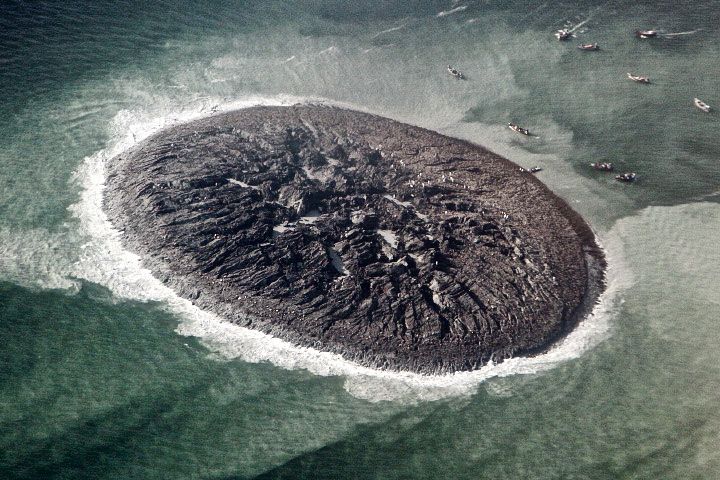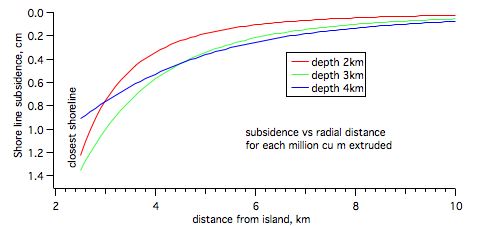
What causes the formation of islands on the Makran shelf?
Transient islands formed on the Makran coast in 1945, 1999, 2010 (Delisle et al., 2002) and most recently in 2013, but there is as yet no unique explanation for their genesis. The 1945 and 2013 islands were triggered by earthquakes, but the intervening two were not.

Methane Hydrates have been identified on the continental slope south of the Makran coast (von Rad et al 1998), but they cannot exist on the continental shelf due to the high water temperatures (>25 deg C), high heat flow (>40 mW/sq m), and low hydrostatic pressures (40-100 m ) near the lowest temperatures in the sea floor sediments. Methane outgases from the sea floor at depths shallower than about 800 m, but at deeper depths on the continental slope its upward passage is trapped in a solid clathrate phase (see figure).

Figure adapted from Tabrez et al, 2012 and von Rad et al. 1998.
In a 24 Sept interview with Richard Harris of Public Radio I suggested that methane hydrates played a role in driving the recent emergence of islands. The suggestion was that pressure release from transient seismic waves, or a local submarine slump would destabilize the solid clathrates which would then shift to a gas phase raising more clathrates mechanically to lower pressures, which would then rise to the surface with muds and gas bubbles until the local source of clathrates was exhausted. While such mechanism may exist in deep, cold waters and result in modest sea floor diapirs (Manga et al., 2009), this theoretical mechanism is clearly untenable in Makran given anticipated pressure/temperature conditions illustrated above.
Yet methane is associated with the rising mud plume and plays a role in driving the sediments to the surface, presumably by lowering their mean density. The emplaced sediments are unusual in that they are not jumbled or folded, although they are offset by large shear planes accompanying emplacement. Offsets of more than >2 m on a 50 m long fracture are evident suggesting weak shear strength compared to normal rocks, yet the sediments are evidently strong enough to support the weight of people and rocks, and large free scarps without failure. DeLisle et al(2020) suggest that the sudden energy release implied by the rapid appearance of the islands is triggered by overpressured liquids and/or dissolved gases. Manga et al., (2009) provide provide a review of alternative mechanisms.
The formation of mud volcanoes is typically associated with a region of subsidence due to the transfer of subsurface volume to the surface (Lerche & Bagirov, 1999). DeLisle et al. (2002) estimate a 2 m subsidense of the sea floor around Malan Island in 1999. The recent volcano is associated with significantly smaller subsidence. If we assume zero volume change of its constitutive sediments during extrusion, and that the mud comes from a shperical volume at 2-4 km depth, the recent island near Gwadar has lowered the nearby shoreline by roughly 1 cm for each million cubic meters extruded, decaying along the shore as indicated in the figure below (Mogi, 1958).

References
Delisle, G., U. von Rad H. Andruleit C.H. von Daniels A.R. Tabrez A. Inam, (2002) Active mud volcanoes on- and offshore eastern Makran, Pakistan, Int J Earth Sciences, Geol Rundsch, 9, 93-110
Lerche, I & E. Bagirov, (1999) Impact of Natural Hazards on Oil and Gas Extraction - The South Caspian Basin, Springer ISBN 13: 9780306462856
Manga, M., M.Brumm, M. L. Rudolph (2009) Earthquake triggering of mud volcanoes, Marine and Petroleum Geology xxx (2009) 1–14
Mogi, K. (1958) Relations between the eruptions of various volcanoes and the deformations of the ground surfaces around them. Bulletin of the Earthquake Research Institute, University of Tokyo, 36, 99-134,
Rad, U.Von, H. Rosch, U. Berner, M. Geyh, V. Marchig, and H. Schulz, 1996, Authigenic Carbonates Derived from Oxidised Methane Vented from the Makran Accretionary Prism Off Pakistan: Marine Geology, 136, 55-77.
Rad U.,Von, H. Doose, G. Delisle, M. Wiedicke, U. Berner, D. Steinmann, A.R. Tabrez, A.A. Khan, M. Ashraf, and M. Pervaz, 1998, The Makran Accretionary Wedges Off Pakistan, Tectonic Evolution and Fluid Migration - Part II, SONNE Cruise SO-130 (3 April - 3 May 1998) Cruise Report and Preliminary Results: Published by BGR, Germany, p. 152.
Tabrez A. R., and A. Inam, (2012), Hydrocarbon Potential in the Makran Offshore Area Search and Discovery Article #80218 (2012)** Posted May 31, 2012